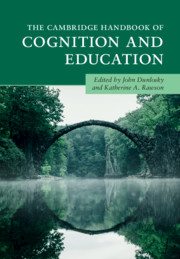Book contents
- The Cambridge Handbook of Cognition and Education
- The Cambridge Handbook of Cognition and Education
- Copyright page
- Contents
- Figures
- Tables
- Contributors
- How Cognitive Psychology Can Inform Evidence-Based Education Reform
- Part I Foundations
- Part II Science and Math
- 3 Teaching Critical Thinking as if Our Future Depends on It, Because It Does
- 4 Improving Students’ Scientific Thinking
- 5 Spatial Skills, Reasoning, and Mathematics
- 6 Iterative Development of Conceptual and Procedural Knowledge in Mathematics Learning and Instruction
- 7 Development of Fraction Understanding
- 8 Learning How to Solve Problems by Studying Examples
- 9 Harnessing Our Hands to Teach Mathematics
- Part III Reading and Writing
- Part IV General Learning Strategies
- Part V Metacognition
- Index
- References
6 - Iterative Development of Conceptual and Procedural Knowledge in Mathematics Learning and Instruction
from Part II - Science and Math
Published online by Cambridge University Press: 08 February 2019
- The Cambridge Handbook of Cognition and Education
- The Cambridge Handbook of Cognition and Education
- Copyright page
- Contents
- Figures
- Tables
- Contributors
- How Cognitive Psychology Can Inform Evidence-Based Education Reform
- Part I Foundations
- Part II Science and Math
- 3 Teaching Critical Thinking as if Our Future Depends on It, Because It Does
- 4 Improving Students’ Scientific Thinking
- 5 Spatial Skills, Reasoning, and Mathematics
- 6 Iterative Development of Conceptual and Procedural Knowledge in Mathematics Learning and Instruction
- 7 Development of Fraction Understanding
- 8 Learning How to Solve Problems by Studying Examples
- 9 Harnessing Our Hands to Teach Mathematics
- Part III Reading and Writing
- Part IV General Learning Strategies
- Part V Metacognition
- Index
- References
Summary
- Type
- Chapter
- Information
- The Cambridge Handbook of Cognition and Education , pp. 124 - 147Publisher: Cambridge University PressPrint publication year: 2019
References
- 12
- Cited by



